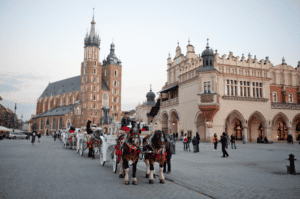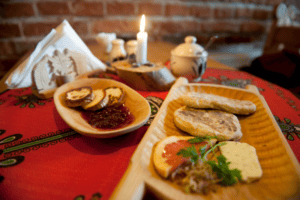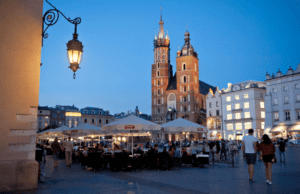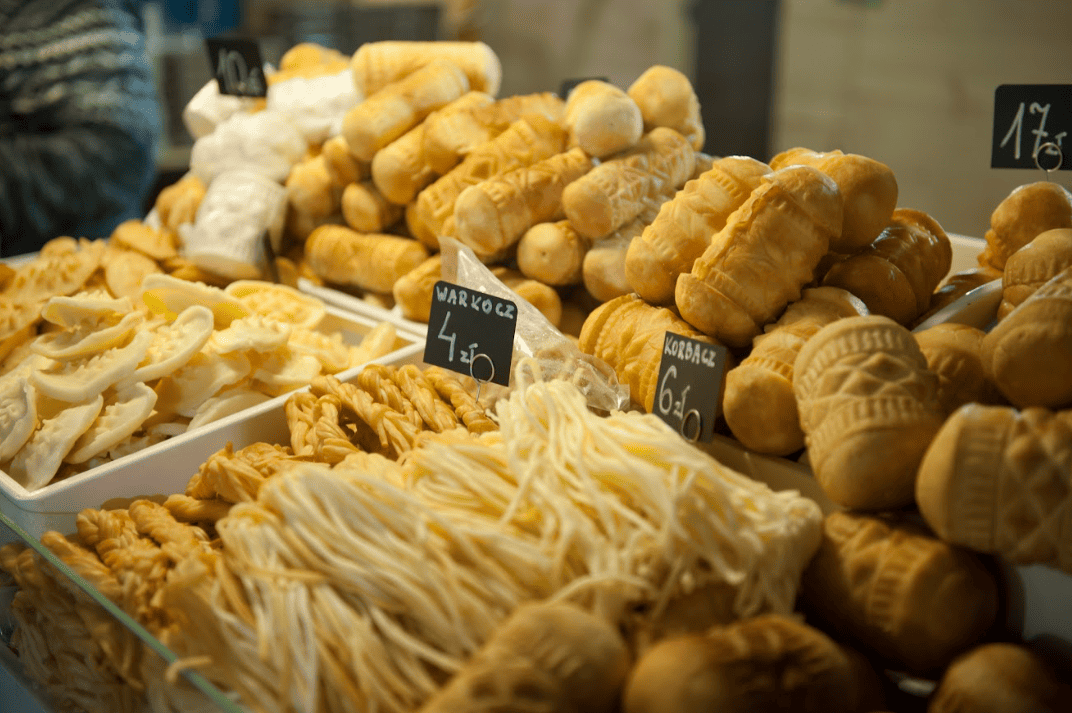In the heart of Krakow, a city where history resonates in every corner, the culinary legacy of royal feasts still lingers, offering a taste of the past in every bite. While the Krakow Food Tour provides a glimpse into this rich culinary landscape, the true essence of the experience lies in the city’s long-standing tradition of regal dining. Here, the echoes of royal banquets continue to influence the local cuisine, turning every meal into a celebration of Krakow’s storied past.
This journey is more than just a tour of Krakow’s famed eateries; it’s an exploration of how centuries-old traditions of royal feasts have shaped the city’s culinary identity. From the opulent halls of Wawel Castle to the humble family tables, Krakow’s gastronomy has been sculpted by a history of grand banquets and sumptuous feasts. These regal meals, once the exclusive domain of monarchs and nobility, have left an indelible mark on the city’s food culture, infusing it with flavors that are both timeless and inviting.
Krakow’s Gastronomic Canvas: A Blend of History and Flavor
Krakow, a city rich in history and culture, has a culinary scene that reflects its diverse past. The gastronomy here is a blend of local traditions and foreign influences, particularly from its time under the Austrian Habsburgs in the 19th century. This era brought the Viennese café culture to Krakow, leading to the creation of iconic cafes and introducing delicacies like the Viennese apple strudel and Pischinger, a popular chocolate cake.
The city’s baking and butchery traditions are integral to its culinary identity. Artisanal bakeries, some over a century old, uphold Krakow’s baking heritage, using traditional methods and ingredients. In the world of butchery, Krakow is renowned for its dry sausage and Kiełbasa lisiecka, a high-quality smoked pork sausage, both of which are protected as traditional products.
Street food in Krakow is another highlight, offering a unique experience that combines the city’s Mediterranean café culture with traditional Polish fare. The annual Pierogi Festival, for instance, showcases a wide variety of these beloved dumplings, ranging from classic fillings to innovative creations. The city’s streets also feature dishes like maczanka krakowska, a testament to Krakow’s ability to adapt and reinvent its culinary traditions.
Festivals and cultural events in Krakow celebrate the city’s diverse cultural heritage and contribute significantly to its food culture. Events like the International Jazz Festival and the Jewish Culture Festival are just a few examples that highlight the city’s culinary diversity.

The Legacy of Royal Feasts in Krakow
The history of royal feasts in Krakow is as rich and multifaceted as the city itself, deeply interwoven with its architectural and cultural development. The Wawel Royal Castle and Cathedral, the epicenters of royal life in Krakow, have played a pivotal role in shaping this legacy.
Wawel’s history as a royal residence dates back to the 11th century, with significant developments occurring during the reigns of King Ladislaus I the Short and King Casimir III the Great in the 14th century. The first historically recorded coronation of a Polish ruler at Wawel was that of Ladislaus I in 1320, which marked the beginning of Krakow’s significance as a royal city. King Casimir III, known for his reforms and development of the Polish state, further elevated Wawel’s status, transforming it into a splendid residence.
The arrival of the Renaissance in the early 16th century brought an era of prosperity and cultural exchange to Wawel and Krakow. King Alexander and his brother, Sigismund I the Old, commissioned the construction of a new Renaissance palace, which was completed around 1540. This period saw increased patronage of the arts and culture, attracting artists and scholars from across Europe. Wawel Castle became one of Europe’s leading centers of humanism, its halls adorned with magnificent Flemish tapestries and artworks. The royal feasts of this era were not only lavish culinary displays but also celebrations of the flourishing arts and culture.
The Jagiellonian dynasty, which ruled from the late 14th to the late 16th century, further enhanced Krakow’s status as a cultural and political hub. The marriage of Polish Queen Hedwig and Lithuania’s Grand Duke Jogaila formed the Polish-Lithuanian Commonwealth, a significant European power. This union brought further prosperity to Krakow, making it the political center of a vast realm. During this period, royal feasts in Krakow would have reflected the city’s status as a crossroads of European cultures and influences.
In 1596, the capital of Poland was moved to Warsaw by Sigismund III Vasa. However, Krakow continued to hold significant cultural and historical importance. Wawel Cathedral remained the coronation site for Polish kings, maintaining the city’s connection to its royal past. Krakow’s legacy as a former capital and royal city has profoundly influenced its culinary traditions, with royal feasts leaving an indelible mark on the city’s gastronomic identity. The traditions and recipes from these feasts have trickled down through the centuries, influencing the modern culinary landscape of Krakow.
Today, Krakow’s culinary scene pays homage to its royal heritage. Traditional Polish cuisine, influenced by the city’s rich history, can be seen in the preservation of classic recipes and the adaptation of royal dishes by contemporary chefs. This blend of historical reverence and modern creativity ensures that the legacy of Krakow’s royal feasts continues to be a vital part of the city’s cultural and culinary identity.

Krakow’s Culinary Crown: Rediscovering the City’s Royal Feasts
Krakow’s culinary crown is adorned with dishes that hark back to the city’s royal heritage, rich in both flavor and history. The royal feasts of Krakow, particularly during the 16th to 18th centuries under the Polish nobility, were characterized by lavish spreads that included a variety of meats, vegetables, and rich flavors. These feasts, known as ‘dworska kuchnia,’ featured wild game, poultry, and fish such as deer, boar, pheasant, quail, goose, duck, trout, and carp. Vegetables sourced locally were common, and these meals were often enjoyed with mead, wine, or beer.
Traditional Dishes with Royal Roots
Several traditional Polish dishes trace their origins to these royal feasts and have been preserved or adapted over the centuries:
- Bigos: A hearty meat and cabbage stew, often made with leftover meat parts, sausage, onions, mushrooms, garlic, and a mix of fresh and pickled cabbage. While there is no standard recipe for Bigos, it is a dish that embodies the hearty and filling nature of royal cuisine.
- Kielbasa: A Polish sausage made with pork, beef, or poultry, seasoned with garlic, pepper, and spices. Kielbasa is a versatile dish that can be grilled, boiled, or fried, often served with bread or potatoes.
- Barszcz: A traditional Polish beetroot soup, often served with sour cream and bread. It can be enjoyed hot or cold and is a staple during Christmas and Easter.
- Gołąbki: Stuffed cabbage rolls typically filled with meat, rice, and spices, cooked in tomato sauce or broth, and served with potatoes or bread.
- Pierogi: These are doughy dumplings, filled with a variety of ingredients like potatoes, cheese, meat, or fruits. Pierogi are a versatile dish that can be served boiled, fried, or even as a dessert.
Today, Krakow’s culinary landscape sees a resurgence of these traditional dishes, often reimagined by contemporary chefs. Restaurants and eateries throughout the city offer these classic dishes, allowing visitors and locals alike to experience a taste of royal Krakow.
For instance, restaurants like Wierzynek, which has been a culinary landmark since 1364, offer a glimpse into Krakow’s royal past with their menu. They serve dishes that blend the noble cuisine of old with modern culinary techniques and presentation. Similarly, other establishments throughout Krakow, such as Pod Aniołami, Jarema, Kogel Mogel, and Morskie Oko, provide diners with an authentic taste of traditional Polish food, reminiscent of the grand royal feasts.

A Taste of History: Highlights from the Krakow Food Tour
The Krakow Food Tour offers a delightful exploration of the city’s culinary heritage, blending its rich history with vibrant flavors. Here’s a brief overview of what the tour entails:
- Starting Point: The tour begins in the historic Jewish Quarter of Kazimierz, known for its unique blend of history, culture, and gastronomy.
- Royal Route to the Old Town: From Kazimierz, the journey continues along the Royal Route to the Old Town. This path is lined with medieval architecture and leads to the main market square, a bustling center surrounded by modern dining establishments.
- Culinary Stops: Key highlights of the tour include tastings of traditional dishes like toasted zapiekanka, beetroot soup with Polish sausage, classic pierogi, hearty bigos (hunter’s stew), and smoked sheep cheese (oscypek) with cranberry jam.
- Sweet Treats: The tour also indulges in sweet flavors, featuring Polish donuts filled with traditional rose jam.
- Traditional Beverages: To accompany the food, the tour includes tastings of honey-flavored vodka and Polish beer, offering a glimpse into the country’s rich beverage culture.
- Conclusion: The tour concludes near the Krakow Barbican, leaving participants with a richer appreciation of Polish cuisine and culture.
This brief overview captures the essence of the tour, but if you’d like to have the full details, check out the Krakow Food Tour official page and book your tour. We promise you’ll have an unforgettable experience.
